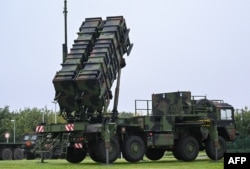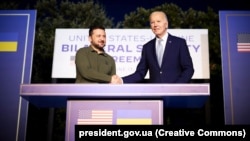WASHINGTON -- When the U.S. Congress approved $61 billion in aid for Kyiv in April after a six-month delay that cost Ukraine territory and a large chunk of its energy system, a nagging question immediately emerged: Was this the last major support package for a country fighting a massive Russian invasion?
With U.S. public backing for Ukraine withering after more than two years of full-scale war, especially among Republican voters, would there be enough will in Congress to pass another large aid package in 2025? Would there be any U.S. aid package if former President Donald Trump, the presumptive Republican contender in the November 5 election, returns to the White House in January?
Over the past two weeks, the United States and European governments have taken some of the urgency out of the answers to those questions, approving steps aimed to ensure that Ukraine remains financially afloat and able to defend itself well into 2025 regardless of election outcomes.
Meeting in southern Italy on June 13-15, the Group of Seven nations agreed to loan Ukraine $50 billion that will be paid down by the interest income and profits generated from the $260-300 billion in Russian central bank reserves frozen in the West as punishment for the invasion. Ukraine will begin receiving the money this year; it will be used for military procurement, budget needs, and reconstruction -- particularly of its energy infrastructure, which has been devastated by Russian attacks.
On the sidelines of the summit, U.S. President Joe Biden and Ukrainian President Volodymyr Zelenskiy signed a 10-year bilateral security agreement, echoing similar pacts that other Western allies have concluded with Kyiv. Under the agreement, the United States will encourage U.S. defense companies to set up joint ventures with Ukrainian companies and co-produce critical weapons and ammunition inside the country, reducing its dependence on Western aid.
"Putin's strategy is to wait out the West and wait out Ukraine and eventually to win" by turning it into a failed state, Charles Kupchan, a senior fellow at the Council on Foreign Relations and professor of international affairs at Georgetown University, told RFE/RL.
"The allies made it clear to Putin that it wouldn't happen. It is an extraordinary message to send," he said.
Additional Western support for Ukraine may be on the way. At a July 9-11 summit in Washington, NATO is expected to announce an agreement by member states to continue military support, further buttressing Ukraine through 2025. NATO Secretary-General Jens Stoltenberg is seeking an annual commitment of $40 billion and is also due to announce plans by NATO to take the reins of coordinating allied military aid from the United States.
Meanwhile, the Biden administration announced on June 20 that it had agreed with allies to ship Patriot and National Advanced Surface-to-Air Missile Systems (NASAMS) rolling off the production lines and initially destined for other nations to Ukraine to help repel Russian attacks.
Ukraine will begin receiving the Patriots and NASAMS later this summer, and the supply will be sufficient to cover the country's needs through late 2025, the White House said. They will help Ukraine defend itself against Russian jets and intercept missiles aimed at its energy sector, among other targets.
A major reduction or end to U.S. aid could be severely detrimental to Ukraine's war effort, as evidenced by the setbacks it suffered as ammunition and air defense ran low while Republican lawmakers with Trump's support were blocking the $61 billion package proposed by Biden in October.
The United States is Ukraine's largest backer, having allocated about $175 billion in military, financial, and humanitarian aid to the country since the start of Russia's full-scale invasion in February 2022, and has played the lead role in coordinating military support from NATO allies.
In a June 20 report, Liam Peach, senior emerging markets economist at London-based research firm Capital Economics, said the $50 billion loan "may help to safeguard support for Ukraine over the coming years against potential changes in political winds in the West including a victory for Donald Trump in the U.S. election." The amount is slightly greater than Ukraine's budget deficit for 2024.
Kupchan cautioned that large-scale Western support through 2025 and beyond is not etched in stone, with Trump and European right-wing leaders vying for power. French President Emmanuel Macron, a staunch supporter of Ukraine, this month called snap parliamentary elections after France's right-wing party had a strong showing in EU elections.
"Is this a full-proof plan? Absolutely not, because we don't know who is going to win the U.S. election and the French election. If you have governments ready to turn off the spigot of aid, then things get a lot more complicated," he said.
Trump has not said clearly what he would do about aid to Ukraine if elected. At a campaign rally on June 16, two days after the West announced the $50 billion loan, he said Zelenskiy's lobbying for aid "never ends."
Trump also repeated a claim that he would end the war quickly, saying he would "have that settled" within weeks if he wins the election. He has not said how he would do that, and there is no sign that the sides are close to negotiations.
Steven Pifer, the U.S. ambassador to Ukraine from 1998-2000 and now an analyst with the Brookings Institution, told RFE/RL the $50 billion loan to Ukraine and NATO's greater role going forward in organizing assistance to Ukraine represents "a sort of a hedge against a Trump victory" in November.
Pifer said he would not expect Trump to request another aid package for Ukraine in 2025 if he wins. A Biden victory, on the other hand, might make passage a bit easier even if the Republicans still control the House of Representatives, he said.
Kupchan said he thinks Trump would approve an aid package next year if elected in November.
"Trump's default position will be to very significantly diminish foreign aid across the board with assistance to Ukraine being at the top of his list," he said.
But it wouldn't go to zero next year, he predicted, because "Trump doesn't want to go down in history as the American president who threw Ukraine under the bus and who handed Ukraine to Vladimir Putin."


